


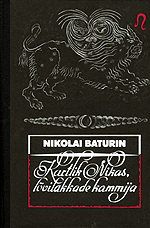
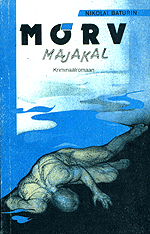
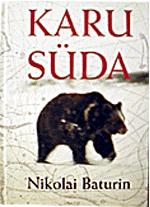
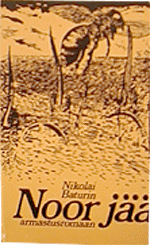
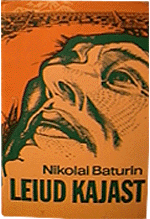


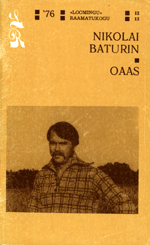
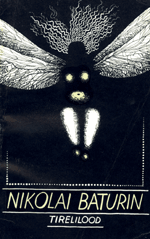
THE CENTAUR
Tallinn : Eesti Raamat, 2003, 573 pp.
The Centaur , an award-winning book of the 2002 novel competition, is the latest from Nikolai Baturin. Its story and structure are very similar to an action film. With its visual expressiveness, rapidly alternating images and gripping events The Centaur falls into a very specific genre of the film novel .
The keywords in the novel are: oil fields in the desert and in the sea. A fight to control oil. The search for meaning of life and the choice of vocation. Two different worlds - the Christian and the Muslim worlds compared. Myth interwoven with historical reality. The differences between the similarities of a man and a woman; eternal and novel aspects of love. Refuge after life and death.
Read further
APOCALYPSE ANNO DOMINI
Synopsis and a proposal for screening
(if there is enough interest, this can be expanded into a longer summary)
Description and justification : With its world-scale problems, its originality of the main idea and its fast moving action Apocalypse Anno Domini shows strong potential to be turned into a film.
This is a psychological novel drawn from real life experience which warns of the imminent spiritual death of the HUMAN BEING, the only creature on the earth who has a soul (the leading theme of the novel written in 1996 coincides with Pope John Paul II's warning in his encyclical letter of 1998 about knowledge dominating the soul, which leads to the perdition of the human being).
The basic idea : As we all know the Apocalypse in Christian thinking is the expectation of an imminent cosmic cataclysm. In the context of this novel the Apocalypse is the vision of the end of the world in which we live. To the extent that we live rightly or wrongly it is possible for us to scatter or deepen our vision of the end of the world.
The screened version of Apocalypse Anno Domini, a staged end-of- the-world, could - if brilliantly set - serve as a warning of the real APOCALYPSE, the destruction of the infinitely complex web of life and of the only creature with a soul on the earth, or, it could even serve to avoid the destruction.
The structure of the novel (or a potential screenplay):
The story moves between time frames – the distant future , which is the present, the here and now in the novel.
The past , approximately the present time, in which the main events take place. In the finale the events are brought to the frame story, at which point the culmination is reached.
The structure of Apocalypse Anno Domini is simple (it is easy to watch and understand) but it has an esoteric flavour, which should appeal to the most discerning public.
In its genre the novel is a psychological thriller , with the elements of a social drama, which keeps the audiences riveted till the very end, till the very last pages (last minutes).
From the publisher:
Apocalypse AD is a warning for the mankind. The invisible powers hidden behind a mask have triggered a chaos, very much like the end of the world, even more horrible than death. The mankind is infected with a mysterious mental disease, which spreads pandemically, and the criminologist Burmeister, Head of the Bureau of the Investigation into Especially Dangerous Crimes (in the frame of the novel his name is Bushmeister) has been sent on a mission to save the world …
…shot through the heart, he has a new heart transplanted, and continues to live and fight. Who will win: is it the genius investigator or the criminal mastermind?
Apocalypse Anno Domini was awarded the second prize at the 1996 novel competition (it was singled out as the best social-problem novel)
CAUGHT IN A VICIOUS CIRCLE
Tallinn: Eesti Raamat, 216 pp.
(From the cover of the book)
The novel is set in an unpredictable future (or past, or present, as the author says). A motto in this strange dictatorship is: each person, whoever or whatever s/he is, should take chances. The protagonists, Mattes and his wife Teresa, who are deeply in love with each other, live in their dreams in the past, but in their work and daily life they are connected with the all-too-brutal modern world, which, inevitably, affects them. Gradually they are becoming estranged, until an unexpected twist at the end.
TIMID NIKAS, THE COMBER OF LIONS' MANES
Tallinn: Eesti Raamat, 1993, 472 pp.
Author's illustrations.
This book by the acclaimed author of The Heart of the Bear (1989) deals with beginnings and basic truths. Pre-war, wartime and post-war events seen through the eyes of a child form the background for the child's sufferings and upliftings. However, the author does not aim at creating a realistic picture, instead, he offers a fascinating mythological panorama, making extensive use of biblical quotations and parallels, Classical symbols and the grotesque. Thus the novel operates on a multiplicity of levels.
A MURDER AT THE LIGHTHOUSE
Tallinn: Eesti Raamat, 1993, 176 pp.
The novel is set in a remote idyllic seaside village where among the ordinary holidaymakers there are a few famous people. One morning the body of Karl Sonning, a renowned nuclear physicist is found on a stretch of the sand near the sea, a small nickeled anchor tied on a ribbon around his foot. Inspector Kollom takes up the case; during the investigation a complex web of relationships is disentangled, the suspects are questioned one after another amd their alibis confirmed.
The question remains: who is the murderer?
THE HEART OF THE BEAR
Tallinn: Eesti Raamat, 1989, 496 pp. Author's illustrations.
This is Nikolai Baturin's third novel presented as eleven virtual halts of a fur trapper on his journey through temporal, human and primeval landscapes. This is a quest for the heart of the Wilderness, a journey toward life awareness and self awareness. At the same time this journey is also an attempt to overcome the negative aspects of our civilisation, superficiality in human relationships and one's bad ego.
EARLY ICE
Tallinn: Eesti Raamat, 1985, 144 pp.
Af first glance this might seem a family drama , in which the action centres around the break-up of a family. However, the author's interest does not lie so much in the plot as in the complicated and mysterious nature of human relationships, the dialectic of love and egoism. Early Ice could also be seen as a novel about one's roots, faithfulness to one's place and work, faithfulness to oneself.
ECHO FINDS
Tallinn: Eesti Raamat, 1977, 229 pp
This is the story of the Journey of Life, its rises and falls. Similarly to things human beings have their intrinsic value which defines their moral standing, their claim to be faithful friends or lovers. This becomes clear when your entire life - in a majestic meteoric flight - flashes before your eyes before you die.
Read further
KING OF THE KING'S CABIN
Tallinn: Eesti Raamat, 1973, 214 pp.
This is a story of the trapper's year spent in the Siberian taiga. The reader learns what happens on a trapper's path in spring, summer, autumn and winter as well as what goes on in the heart of the trapper who searches for the meaning of life and for the eternal mystery of existence in the wilderness.
Read further
AT AN EARLY LATE HOUR
Tallinn: Perioodika, 1974, 72 pp.
Some like believable stories
And some believe what they like.
A poem in prose
This is a playful, in places a rather dramatic story of village life. The author has turned it into a libretto for a ballad opera or a musical.
Note: For a more detailed overview, see the synopsis of A GHOST IN THE CUPBOARD, a theatre of reading.
The “theatre of reading” presented in two of Baturin's books breaks away from classical dramaturgical canons. Visual metaphorics are linked with music, song, dance, and pantomime. The author handles the themes of Love and Death, Evil and Good with masterful psychological subtlety, sometimes relying on heavy emotional contrasts. /L.Epner, literary critic/
Anyway, Baturin has introduced a novel-like drama into our theatre scene, creating a world of his own.
/P. Kruuspere, theatre critic/
THE OASIS
Tallinn: Perioodika, 1976, 83 pp. A short story.
Desert is the place of abandonment.
There is very little to choose from: complain of thirst.
Or go and search for a spring.
The author's remarks:
In a philosophical sense the Oasis is not only a physical feature but a spiritual landscape, the spiritual oasis. Each human being has its own Desert and its own Oasis.
“ Is an oasis when it's not surrounded by a desert an oasis? I believe when deserts disappear from around the oases, they invade right into the oases.” (An excerpt from the story)
“The desert is filled with golden silence and the beating of our hearts –it's just the oppsite when the desert and its golden silence are in your heart.” (an excerpt from the story)
“Time in the desert can be measured in two different ways. There is the clock time, and there is the time of our heartbeats.” (excerpt from the story)
Note: The short story “THE OASIS” is the third part of the novel ECHO FINDS,
read further in the synopsis of the novel.
“ Baturin's Desert and Oasis can be understood and interpreted very widely: these notions can be expanded to almost all the domains of human life, to the soul of a human being, to the whole world. The Desert and the Oasis are both concrete and symbolic images. To arrive at an Oasis means to have a clear idea of what you are after.”
/M. Jõgi, literary critic/
SOMERSAULTS
Tallinn: Eesti Raamat, 1980, 224 pp.
This is a collection that includes pieces in three different genres: it begins with a
lyrical poem in prose “At An Early Late Hour”, to be followed by a cycle of poems under the title of “Echos from Two Banks” and an antimilitaristic play with an element of the grotesque “An Anecdote about Charon's Boat” . Although the parts are stylistically different, a certain wistful irony pervades them all. This, however, is balanced out by the author's love of life and beauty.
Brief synopses:
I At an Early Late Hour (a prose poem) is a poetic story of a mythical Land of Childhood. With its grotesque characters, dance-like scenes and lyrics it resembles a ballad opera or a mucical. On the basis of this prose poem the author has written a libretto for a musical (see The Ghost in the Cupboard ).
II Echos from Two Banks includes poems in standard Estonian and in dialect, they are like echos bouncing from one side of the river to the other.
III. An Anecdote abut Charon's Boat (novel-drama)
From the programme leaflet:
Pointless death and destruction render life and success pointless. Of the fourteen thousand and five hundred wars in the history of mankind fourteen thousand and five hundred have been won. There is a thick layer of soil which is formed by the decomposition of five billion bodies of soldiers on which colourful flowers blossom like coloured monuments to the fallen. Where did/does war start before it reached/reaches the battleground? It might seem that war starts within a human being before it actually breaks out. Feelings of aggression and feelings of peace are equally strong. How are these feelings triggered off? When do the feelings take over? This is the questions I asked myself.
A battlefield. The battle has ended. A motionless scene: damaged equipment, silence, fallen bodies. Two fatally wounded soldiers lying at a cannon regain consciousness. They grab hold of their bayonets to kill each other. But they have no strength left. However, they can still talk. A dialogue between the two “enemies” develops; at first their talk is full of patriotism and hatred. Gradually the horrendous truth is revealed: they have no reason to hate each other. They have much more reason to love each other. Too late! They can barely forgive each other… when CHARON, who ferries the dead, comes over. One of the soldiers pays him with his gold teeth, the other soldier has nothing to pay with, so Charon orders him to tell an anecdote.
FORESTS SPREADING FAR AND WIDE
Tallinn: Eesti Raamat, 1981, 80 pp.
This is a prose poem in which the characters are the FOREST, the TRAPPER and his friend singing from the treetops.
This small prose poem resembles a native American story, a book of forest. Playful language and fascinating poetics take us back to the beginning of the world, when the BIRDS, ANIMALS, AND PEOPLE and their LOVE was created.
(excerpt from a text): “I was in a forest. That is, I lived in a forest, in an enormous forest of the North, in which the echo was my only companion. I was a tree among other trees, there were only “forests spreading far and wide” around me and a big, big SILENCE, so big that it could not be accommodated within a small person. How good that I was so big! But I was thinking of smaller ones all the time; I heard and remembered the moving shadows of treetops on the days when the winds blew. I want to spill out. I want to put everything down to clear my chest. I will dedicate these stories to the naughty children, just because they are usually dedicated to the good ones.”
“Let's go and live in the forest”, one tree said to another.
And on they went, and went… until they got there!
“As an intensely imaginative creator Baturin composes bizarre worlds, or to be more exact, he reveals the essence of things beneath the surface of the ordinary” (from a review)